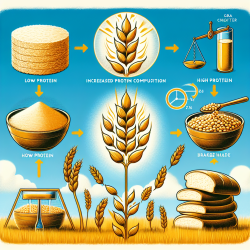Unlocking the Power of Durum Wheat: Simple Tweaks for Big Gains!
Durum wheat, traditionally known for its use in pasta, is making waves in the food industry with new research revealing ways to enhance its versatility. By modifying its protein and starch composition and altering its grain hardness, durum wheat can now be used in a wider range of food products, offering both technological and nutritional benefits.
Protein Composition: The Secret to Better Bread
Durum wheat's protein composition has been a limiting factor in breadmaking due to its lack of D-genome glutenin proteins. However, recent advancements have introduced Glu-D1 subunits, which can significantly improve dough strength. For practitioners, this means experimenting with durum wheat varieties that incorporate these subunits could lead to better bread quality, particularly in environments with weak gluten strength.
Starch Modification: A Nutritional Boost
Starch in durum wheat is composed of amylopectin and amylose. By manipulating the synthesis of these components, researchers have developed durum wheat lines with varying amylose content, ranging from 2-3% to 75%. This modification opens the door to creating products with enhanced nutritional value, such as high-resistant starch foods that support digestive health and may help prevent chronic diseases like type II diabetes.
Grain Hardness: Milling Made Easy
Traditionally, durum wheat's hard texture required specialized milling processes. However, the development of soft-textured durum wheat allows it to be milled like soft hexaploid wheat, without sacrificing pasta quality. This innovation not only makes milling more accessible but also expands the potential applications of durum wheat in various food products.
Opportunities for Practitioners
- Explore durum wheat varieties with modified protein and starch compositions to improve product quality and nutritional value.
- Experiment with soft-textured durum wheat for easier milling and broader application in food products.
- Stay informed about ongoing research and advancements in durum wheat modification to continually enhance your offerings.
By embracing these modifications, practitioners can unlock new potentials in durum wheat, creating diverse and nutritious food products that meet the evolving demands of consumers.
To read the original research paper, please follow this link: Increasing the Versatility of Durum Wheat through Modifications of Protein and Starch Composition and Grain Hardness.










